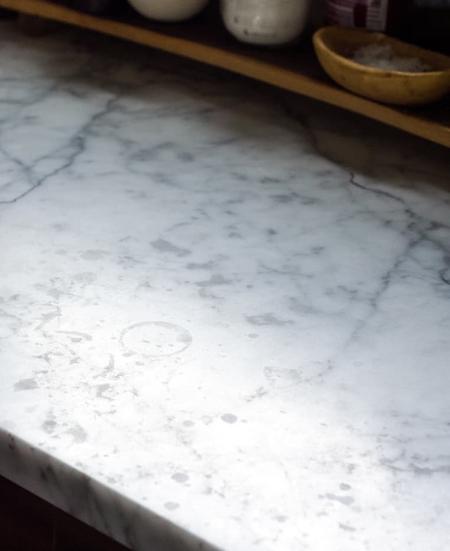Maintaining and fixing marble countertops
Maintaining and fixing marble countertops
Marble is beautiful, no one can dispute that. Its characteristics from patterns to colors, are what make the stone special. It is understandable why people choose to have marble kitchen countertops There are a number of stone colors available in granite although none can match the beauty of a veined white marble.
Marble has long been the stone of choice from castles of old to commercial applications of the finest quality. Monuments to ballroom floors, window sills to sophisticated foyers, it is a stone that rarely competes with other elements for attention, though it can blend in or serve as the centerpiece of a room, depending on its pairings.
To start understanding marbles and how to take care of them, we need to know some basics, like what type of marble you have and what specific characteristic they have, since not all marble will react the same to wear an tear of domestic use. We also need to know that all marbles, with no exception, will etch with acids, some marble slower than others.
Etching
 What is etching? the reaction to acids like (lemon juice, tomato juice, pinepple etc) to the stone, not cleaned right way will dull the surface. If the stone is a honed or leather finish the etching is masked within the surface. It’s not a stain or a gouge, so you really only see it when the light is right and you’re standing at the right angle. They’re like water spots or dull marks on the marble.
What is etching? the reaction to acids like (lemon juice, tomato juice, pinepple etc) to the stone, not cleaned right way will dull the surface. If the stone is a honed or leather finish the etching is masked within the surface. It’s not a stain or a gouge, so you really only see it when the light is right and you’re standing at the right angle. They’re like water spots or dull marks on the marble.
Most people that choose to have marble countertops, are ok with some etch marks, it becomes a subtle layer of your own use and cooking the story they’ve left on the counters.
Observe closer on marble bars in fancy hotels or restaurants, and you’ll see the same skim of etches floating like an overlay above the stone. It becomes part of the pattern and the beauty of the stone.
A very simple tip is using cutting boards to protect against scratching and direct contact with food juices that may etch.
Types of Marble
There is an incredible variety of different marbles, but they separate in categories depending of their characteristics and durability.
The more knows are the Italians, Turkish and Spanish marbles, like for example Carrara, Diana Royal or Crema Marfil. This marbles have a higher content of calcium, what akes them softer and more susceptible to chip and etching.
More durable marbles are Dolomites and Calcites, this types of marble are denser, and lower content of calcium can make them a bit more resistant to the etching, giving you more time to clean the surface before the etching starts. Also they are harder to scratch or chip. Calcites are a crystallized stone, which gives it the appearance of sparkles, this crystallized structure makes the stone more resistant to etching.
Danby Marbles, american quarried marble, It is harder and less porous than many other types of white marble. For example, Vermont Danby’s absorption rate is .06%-0.08% vs. 0.13-0.18% for Calacatta or Carrara. Also more durable for kitchens, and slower etching process.
Sealing
It doesn’t mean that having less absorption rate will avoid stains, all natural stone is porous, some less that order depending of the density of each one, so it needs to be seal.
Sealer have come a long way during the years, you can always consult with your fabricator/installer on which kind of sealer they use and its performance. Recommended sealers for natural stones are Non water based sealer, with smaller molecules, this sealer penetrate in the porous of the stone for a longer lasting period.
We recommend Stain Proof sealer produced by the brand Dry Treat. This sealer molecules are hundreds of times smaller than competitor stone sealers and penetrate much deeper into the pore structure and retains natural surface color and finish. 15 year written performance warranty can be provided if applied by a Dry-Treat Accredited Applicator.
Cleaning
General cleaning is simple, another reason for marble’s popularity. Just be sure to avoid products containing acid. Though you can buy non-abrasive stone cleaner specifically tailored to marble, alternatively, you can save money and use a mild, non-abrasive, pH neutral (non-acidic) soap mixed with water, which is all you really need to clean marble countertops.
Fixing etch marks
Etch marks are fixable, that is the beauty of having natural stone, solid rock that can be buffed or repolished as many times you need. Hiring a marble restoration professional will be a guaranteed solution.
There are some products available for repolishing marbles that works fairly well on minor etch marks (We tried Lustro etch remover) with positive results, but this will only work on softer types of marble, the denser the marble, the harder will be to remove the etch by your self.
For honed finish surfaces, can be use a very fine steel wool pad, #000 or #0000 grade, and dry buff the etch by hand usually does the trick. However, if the damage covers a very large area, is very severe (rough to the touch) and you are really into DIY, you may need a more tools, like a hand drill and buffer attachment and buff pads.
